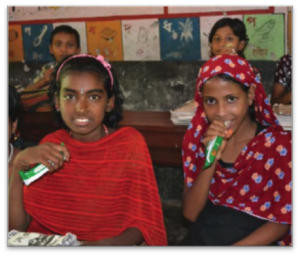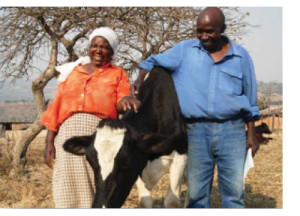
Effective foreign assistance can look a lot like milk and cereal bars.
The Congressional Caucus for Effective Foreign Assistance, co-chaired by Reps. Ander Crenshaw (R-FL) and Adam Smith (D-WA), learned this during a recent briefing on the Economic and Business Case for Foreign Assistance. The caucus was presented development success stories from Land O’Lakes.
The Minnesota company found increasing local involvement in their projects was key to increasing impact abroad.
In 2010, Land O’Lakes International Development ran a one-year U.S. Department of Agriculture-funded pilot program in Bangladesh to determine whether using Local and Regional Procurement (LRP) could improve its development-related food assistance. The project goal was to find out if using only local resources would be both cost-effective and sustainable in the effort to eradicate hunger in the most impoverished areas in Bangladesh.
 The result was wildly successful – Land O’Lakes fed more than 100,000 students and teachers in 441 primary schools in three of the most impoverished areas in northern Bangladesh. It produced 16.3 million fortified, locally-processed cereal bars – a new product for Bangladesh – containing 655 metric tons of nutritious, whole grains sourced from within the country.
The result was wildly successful – Land O’Lakes fed more than 100,000 students and teachers in 441 primary schools in three of the most impoverished areas in northern Bangladesh. It produced 16.3 million fortified, locally-processed cereal bars – a new product for Bangladesh – containing 655 metric tons of nutritious, whole grains sourced from within the country.
In addition, the program invested in capacity building, so that processors could upgrade their plants and food safety, and farmers could improve the quality of what they produce. Today, two companies in the region have been able to launch commercial versions of the cereal bars using the same local ingredients. These companies produce 5.6 million cereal bars each month, and are employing 5,000 local farmers from whom they source their commodities.
Meanwhile, in Zimbabwe, a USAID-funded Land O’Lakes program created a bank – affectionately referred to as the “Cattle Bank” – for local farmers to take out loans to buy livestock, and related inputs and services. To qualify for a loan, farmers needed to attend technical trainings, have a milking parlor, meet established milk quality levels, and pay a financial deposit. To complement the investment in livestock, Land O’Lakes invested in strengthening local Milk Collection Centers, and linking them to commercial processors. Since the program’s inception in 2010, farmers’ annual incomes from milk sales have increased 743%.
 Through these programs, Land O’Lakes found that increasing local involvement and investment in their projects made them significantly more successful. In Bangladesh, the shift to LRP helped the cereal bars reach students six weeks faster than traditional import efforts, saving roughly $0.18 per school feeding. The local production bolstered the economy and benefitted local farmers in a sustainable way that extends well beyond the life of the program. In Zimbabwe, the Cattle Bank incentivized high performance by treating the cattle as an investment. The program also worked with a microfinance organization to develop a new livestock loan product for farmers, which provides more advanced products and up to $5,000 for three cows. Today, farmers are actively taking out livestock loans with 100% repayment rates.
Through these programs, Land O’Lakes found that increasing local involvement and investment in their projects made them significantly more successful. In Bangladesh, the shift to LRP helped the cereal bars reach students six weeks faster than traditional import efforts, saving roughly $0.18 per school feeding. The local production bolstered the economy and benefitted local farmers in a sustainable way that extends well beyond the life of the program. In Zimbabwe, the Cattle Bank incentivized high performance by treating the cattle as an investment. The program also worked with a microfinance organization to develop a new livestock loan product for farmers, which provides more advanced products and up to $5,000 for three cows. Today, farmers are actively taking out livestock loans with 100% repayment rates.
As shown in these examples, Land O’Lakes is focusing its assistance model on ensuring local communities play the leading role in their own development. This has allowed the company to maximize the impact of its resources, while ensuring that programs are sustainable in the long run. Because of that, more people are being reached through Land O’Lakes International Development’s mission to replace poverty with prosperity, and dependency with self-reliance.